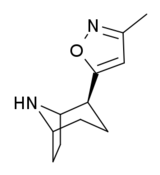Chemistry:RTI-126
 | |
| Legal status | |
|---|---|
| Legal status |
|
| Identifiers | |
| |
| CAS Number | |
| PubChem CID | |
| Chemical and physical data | |
| Formula | C17H21N3O |
| Molar mass | 283.375 g·mol−1 |
| 3D model (JSmol) | |
| |
| |
RTI-126 (RTI-4229-126 or (–)-2β-(1,2,4-oxadiazol-5-methyl)-3β-phenyltropane) is a phenyltropane derivative which acts as a potent monoamine reuptake inhibitor and stimulant drug, and has been sold as a designer drug. It is around 5 times more potent than cocaine at inhibiting monoamine reuptake in vitro, but is relatively unselective. It binds to all three monoamine transporters, although still with some selectivity for the dopamine transporter.[1] RTI-126 has a fast onset of effects and short duration of action, and its pharmacological profile in animals is among the closest to cocaine itself out of all the drugs in the RTI series. Its main application in scientific research has been in studies investigating the influence of pharmacokinetics on the abuse potential of stimulant drugs, with its rapid entry into the brain thought to be a key factor in producing its high propensity for development of dependence in animals.[2][3]
The structurally related compound (–)-2β-(3-methyl-5-isoxazolyl)nortropane is a potent and selective agonist for nicotinic acetylcholine receptors, with twice the potency of nicotine.[4]

See also
References
- ↑ "3-Aryl-2-(3'-substituted-1',2',4'-oxadiazol-5'-yl)tropane analogues of cocaine: affinities at the cocaine binding site at the dopamine, serotonin, and norepinephrine transporters". Journal of Medicinal Chemistry 36 (20): 2886–90. October 1993. doi:10.1021/jm00072a007. PMID 8411004.
- ↑ "Locomotor stimulant effects of novel phenyltropanes in the mouse". Drug and Alcohol Dependence 65 (1): 25–36. December 2001. doi:10.1016/S0376-8716(01)00144-2. PMID 11714587.
- ↑ "Faster onset and dopamine transporter selectivity predict stimulant and reinforcing effects of cocaine analogs in squirrel monkeys". Pharmacology, Biochemistry, and Behavior 86 (1): 45–54. January 2007. doi:10.1016/j.pbb.2006.12.006. PMID 17258302.
- ↑ "Synthesis and nicotinic acetylcholine receptor binding affinities of 2- and 3-isoxazolyl-8-azabicyclo[3.2.1]octanes". Bioorganic & Medicinal Chemistry Letters 14 (7): 1775–8. April 2004. doi:10.1016/j.bmcl.2004.01.025. PMID 15026069.
 |

